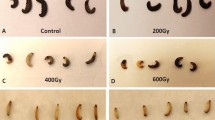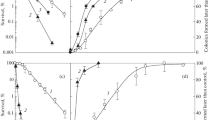Summary
-
1.
L-tryptophan mixed dry with brewers’ yeast, or dissolved in a yeast-agar medium, when fed to larvae of theSu-er bw; st er strain, caused an increase in the incidence of tumours from 4 to over 60%, and in the frequency of erupt eyes from. 9 to over 35%. When embryos were first exposed to pure oxygen, and the same individuals as larvae were subsequently fed tryptophan, the tumour incidence was increased to over 80 % and the erupt eye effect to 50%. Hence, the oxygen treatment must have a long-lasting effect that interacts synergistically with the tryptophan effect.
-
2.
Larvae of this strain have been examined for tumours, and adults for erupt eyes, after the individuals were fed on media containing supplementary tyrosine, phenylalnine anthranilic acid, alanine, indole, serine, or indole plus serine. None of these substances equalled tryptophan in regard to either effect. With respect to melanotic tumours, serine was without effect; phenylalanine produced a slight increase; alanine, about 17%; and tyrosine, or indole plus serine, produced an increase to about 25%. The results with anthranilic acid, and those with indole, were variable in replicated experiments, but both compounds produced a significant increase in the incidence of tumours. In respect to erupt eyes, phenylalanine, or indole plus serine, was without effect. Anthranilic acid or indole produced a slight increase in erupt eyes. Serine, alanine and tyrosine each produced an increase to about 20%.
-
3.
Both indole and serine, when fed alone, proved very toxic. When fed together, this toxicity is seemingly nullified; combination had no effect on the frequency of erupt eyes, and an intermediate effect on the frequency of melanotic tumours. It was shown that the reduction of toxicity and of the respective effects of indole and serine upon the suppression of melanotic tumours and erupt eyes was not due to the coupling of indole and serine by bacterial action.
-
4.
The results obtained with tryptophan, when compared with those obtained with X-rays, oxygen and hydrogen peroxide, suggest the operation of a similar mechanism in these cases, possibly centred on the peroxidative conversion of tryptophan to formylkynurenine.
Similar content being viewed by others
References
Barron, E. S. G. (1954). The effect of X-rays on systems of biological importance. InRadiation Biology, vol. 1:High Energy Radiation (A. Hollaender, ed.), part I, pp. 283–314. New York: McGraw-Hill.
Beadle, G. W. &Tatum, E. L. (1941). Experimental control of development and differentiation. Genetic control of developmental reactions.Amer. Nat. 75, 107–16.
Becker, E. (1939). über die.Natur des Augenpigments vonEpheslia kühniella und semen Vergleich mit den Augenpigmenten anderer Insekten.Biol. Zbl. 59, 597–627.
Becker, E. (1942). über Eigenschaften, Verbreitung, und die genetisckentwicktungsphysiologische Bedeutung der Pigmente der Ommatin und Ommingruppe (Ommochrome) bei den Arthropoden.Z. indulct. Abstamm. — u. VererbLehre,80, 157–204.
Bonner, D. M. (1951). Gene-enzyme relationships inNeurospora.Cold Spr. Harb. Symp. Quant. Biol. 16, 143–57.
Oaspari, E. W. (1949). Physiological action of eye color mutants inEphestia kühniella andPtychopoda seriata.Quart. Rev. Biol. 24, 185–99.
Davis, B. D. (1955). Biosynthesis of the aromatic ammo acids. InA Symposium on Amino Acid Metabolism (W. D. McElroy and B. Glass, eds.) pp. 799–811. Baltimore: Johns Hopkins Univ. Press.
Dunning, W. E., Curtis, M. R. &Maun, M. E. (1950). The effect of added dietary tryptophan on the occurrence of induced cancer in rats.Cancer Res. 10, 319.
Ephrussi, B. (1942a). Analysis of eye color differentiation inDrosophila.Cold Spr. Harb. Symp. Quant. Biol. 10, 40–8.
Ephrussi, B. (1942b). Chemistry of ‘eye color hormones’ ofDrosophila. Quart. Rev. Biol. 17, 327–38.
Ephrussi, B. (1951). Remarks on cell heredity. InGenetics in the 20th Century (L. C. Dunn, ed.), pp. 241–62. New York: Macmillan.
Erspamer, V. &Asero, B. (1952). Identification of enteramine, the specific hormone of the enterochromaffin cell system, as 5-hydroxy-tryptamme.Nature, Land.,169, 800–1.
Fhuton, J. S. &Simmonds, S. (1953). General Biochemistry. New York: John Wiley and Sons; London: Chapman and Hall.
Glass, H. B. (1944). The effect of X-rays upon the action of a specific gene inDrosophila melanogaster.Genetics,29, 436–46.
Glass, B. &Plaine, H. L. (1950). The immediate dependence of the action of a specific gene in Drosophilamelanogaster upon fertilization.Proc. Nat. Acad. Sci., Wash.,36, 627–34.
Glass, B. &Plaine, H. L. (1952). The role of oxygen concentration in determining the effectiveness of X-rays on the action of a specific gene inDrosophila melanogaster.Proc. Nat. Acad. Sci., Wash,38, 697–705.
Glass, B. &Plaine, H. L. (1954a). A biochemical analysis of factors producing melanotic tumors and erupt eyes in the suppressor-erupt stock ofDrosophila melanogaster.Abstr. 9th Int. Congr. Genet. Bellagio (in the Press).
Glass, B. &Plaine, H. L. (1955). Genetic control of tryptophan metabolism inDrosophila. InA Symposium on Amino Acid Metabolism (W. D. McElroy and B. Glass, eds.) pp. 940–4. Baltimore: Johns Hopkins Press.
Gloor, H. (1944). Phänokopie-Versuche mit Äther anDrosophila.Rev. Suisse Zool. 54, 637–712.
Gray, L. H. (1953). The interaction and development of cellular damage by ionizing radiations. Brit.J. Radiol. 26, 609–18.
Green, M. M. (1949). A study of tryptophane in eye color mutants ofDrosophila.Gaieties,34, 564–72.
Green, M. M. (1952). Mutant isoalleles at the vermilion locus inDrosophila melanogaster.Proc. Nat. Acad. Sci., Wash.,38, 300–5.
Hayaishi, O. (1955). Enzymatic studies on the metabolic interrelationship of hydroxy-substituted derivatives of tryptophan and its intermediate metabolites. InA Symposium on Amino Acid Metabolism (W. D. McElroy and B. Glass, eds.) pp. 914–29. Baltimore: Johns Hopkins Press.
Hayaishi, O. &Stanier, R. Y. (1952). The kynureninase ofPseudomonas fluorescens.J. Biol. Chem. 195, 735–40.
Henderson, L. M. (1952). Tryptophan metabolism in the rat.Abstr. Pap., Amer. Chem. Soc, 23c 121st Meet., Milwaukee.
Hinton, T., Noyes, Doris T. &Ellis, J. (1951). Ammo acids and growth factors in a chemically defined medium forDrosophila.Physiol. Zool. 24, 335–53.
Horowitz, N. H. (1947). Methionine synthesis inNeurospora. The isolation of cystathionine.J. Biol. Chem. 171, 255–64.
Jakoby, W. B. &Bonner, D. M. (1953). Kynureninase fromNeurospora: purification and properties.J. Biol. Chem. 205, 699–707.
Kikkawa, H. (1941). Mechanism of pigment formation inBombyx andDrosophila.Geneties,26, 587–607.
Kikkawa, H. (1950). Tryptophane synthesis in insects.Science,111, 495–6.
Kikkawa, H. (1953). Biochemical genetics ofBombyx mori (Silkworm).Advanc. Genet. 5, 107–40.
Kikkawa, H., Ogita, Z. &Fujito, S. (1954). Studies on the pigments derived from tryptophan in insects.Proc. Imp. Acad. Japan,30, 30–5.
Knox, W. E. &Mehler, A. H. (1950). The conversion of tryptophan to kynm’enine in liver. I. The coupled tryptophan peroxidase-oxidase system forming formylkynurenine.J. Biol. Chem. 187, 419–30.
Knox, W. E. &Mehler, A. H. (1951). The adaptive increase of the tryptophan peroxidase-oxidase system of liver.Science,113, 237–8.
Lafon, M. (1939). Recherches sur quelques aspects du besom qualitatif d’azote. Essai sur le besoin qualitatif d’azote chez un insecte:D. melanogaster Meig.Ann. physiol. physicochim. biol. 15, 215–60.
Mehler, A. H. (1955). Metabolism of tryptophan. InA Symposium on Amino Acid Metabolism (W. D. McElroy and B. Glass, eds.) pp. 882–908. Baltimore: Johns Hopkins Press.
Mehler, A. H. &Knox, W. E. (1950). The conversion of tryptophan to kynurenine in liver. II. The enzymatic hydrolysis of formylkynurenine.J. Biol. Chem. 187, 431–8.
Merkel, J. R. &Niokerson, W. J. (1953). Release of mitochondria from yeast cells by the action of metal-chelating agents.Proc. Nat. Acad. Sci., Wash.,39, 1008–13.
Mittler, S. (1952). Influence of ammo acids upon incidence of tumors inTu 50j stock of D.melanogaster. Science,116, 657–9.
Plaine, H. L. (1952). Non-growing brewers’ yeast as the sole medium for rearingDrosophila larvae.Drosophila Inform. Serv. 26, 133.
Plaine, H. L. (1955a). The effect of oxygen and of hydrogen peroxide on the action of a specific gene and on tumor induction inDrosophila melanogaster.Genetics (in the Press).
Plaine, H. L. (1955b). The counteraction by cysteine of the effects of X-rays and of tryptophan on the action of specific suppressor systems inDrosophila melanogaster.Cancer Res. (in the Press).
Plaine, H. L. &Glass, B. (1952). The effect of oxygen concentration upon the induction by X-rays of Melanotic tumors inDrosophila melanogaster.Cancer Res. 12, 829–33.
Rapoport, J. A. (1939). Specific morphomes inDrosophila induced by chemical compounds.Bull. Biol. Méd. exp. URSS,7, 415–17.
Rapoport, J. A. (1947). On the synthesis of gene-products in equimolecular quantities.Amer. Nat. 81, 30–7.
Rudkin. G. T. &Schultz, J. (1949). A comparison of the tryptophane requirements of mutant and wild typeDrosophila melanogaster.Proc. 8th Int. Congr. Genet., Stockholm (Hereditas Suppl.), pp. 652–3.
Sang.J. H. &McDonald, J. M. (1954). Production of phenocopies inDrosophila using salts, particularly sodium metaborate.J. Genet. 52, 392–412.
Schayer, R. W. (1950). Studies of the metabolism of tryptophan labeled withN 15 in the indole ring.J. Biol. Chem. 187, 777–86.
Stekol, J. A. (1955). Synthetic pathways of methionine, cysteine, and threonine. InA Symposium on Amino Acid Metabolism (W. D. McElroy and B. Glass, eds.) pp. 509–57. Baltimore: Johns Hopkins Press.
Stevens, W. L. (1942). Accuracy of mutation rates.J. Genet. 43, 301–7.
Tatum, E. L. &Bonner, D. M. (1944). Indole and serine in the biosynthesis and breakdown of tryptophane.Proc. Nat. Acad. Sci., Wash.,30, 30–7.
Tatum, E. L., Bonner, D. M. &Beadle, G. W. (1944). Anthranilic acid and the biosynthesis of indole and tryptophan byNeurospora.Arch. Biochem. 3, 477–8.
Wilson, Louise P. (1945). Tolerance of larvae ofDrosophila, for amino acids: tryptophane.Growth,9, 145–54.
Wiss, O. (1949). Untersuchungen über das L-Kynurenine-spaltende Enzym ‘Kynurenmase’.Helv. chim. Acta,32, 1694–8.
Wiss, O. &Hatz, E. (1949). über den Abbau des Tryptophans zu Alanin und Anthranilsäure in tierischen Organismus.Helv. chim. Acta,32, 532–7.
Author information
Authors and Affiliations
Additional information
This work was supported in part by a contract with the Atomic Energy Commission, Contract-No-AT(30-1)-1472.
Rights and permissions
About this article
Cite this article
Plaine, H.L., Glass, B. Influence of tryptophan and related compounds upon the action of a specific gene and the induction of melanotic tumours inDrosophila Melanogaster . J Genet 53, 244–261 (1955). https://doi.org/10.1007/BF02993979
Received:
Issue Date:
DOI: https://doi.org/10.1007/BF02993979




